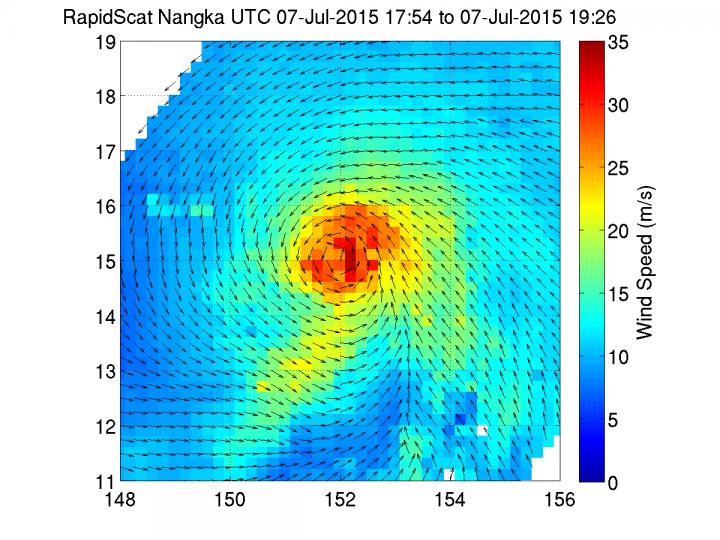NASA sees powerful winds around Typhoon Nangka's center

On July 7, NASA's RapidScat instrument observed Nangka's strongest winds circling the center and reaching speeds of 35 meters per second (78.9 mph/126 kph). Credits: NASA JPL/Doug Tyler
On July 8, a Typhoon Warning was in effect for Agrihan, Pagan and Alamagan in the northern Marianas. A Tropical Storm Warning is in force for Saipan and Tinian.
The RapidScat instrument that flies aboard the International Space Station measures surface winds. When it passed over Typhoon Nangka on July 7 from 17:54 to 19:26 UTC (1:54 to 3:26 p.m. EDT), it gathered data on sustained winds. The RapidScat data showed the strongest sustained winds were near 35 meters per second (78.9 mph/126 kph).
On July 8 at 1500 UTC (11 a.m. EDT), the Joint Typhoon Warning Center (JTWC) estimated Nangka's maximum sustained winds near 115 knots (132.3 mph/213 kph). Nangka was centered near 16.1 North latitude and 148.6 East longitude, about 196 nautical (225.6 miles/363 km) east-northeast of Saipan.
Nangka was moving to the northwest at 9 knots (10.3 mph/16/6 kph). It was generating extremely rough seas and a maximum significant wave height at 36 feet (10.9 meters).
Animated enhanced infrared imagery showed tight bands of thunderstorms spiraling into the 17 nautical mile (19.5 miles/31.4 km) diameter cloud filled eye.
The Joint Typhoon Warning Center (JTWC) forecast calls for Nangka to continue to move west-northwest, while steadily intensifying. JTWC expects Nangka to strengthen to a Category 4 typhoon on the Saffir-Simpson Wind Scale, with sustained winds peaking near 125 knots (143.8 mph/231.5 kph).
Nangka is then expected to start on a weakening trend starting on July 10. For updated forecasts, visit the JTWC web page: http://www.
Media Contact
All latest news from the category: Earth Sciences
Earth Sciences (also referred to as Geosciences), which deals with basic issues surrounding our planet, plays a vital role in the area of energy and raw materials supply.
Earth Sciences comprises subjects such as geology, geography, geological informatics, paleontology, mineralogy, petrography, crystallography, geophysics, geodesy, glaciology, cartography, photogrammetry, meteorology and seismology, early-warning systems, earthquake research and polar research.
Newest articles

High-energy-density aqueous battery based on halogen multi-electron transfer
Traditional non-aqueous lithium-ion batteries have a high energy density, but their safety is compromised due to the flammable organic electrolytes they utilize. Aqueous batteries use water as the solvent for…

First-ever combined heart pump and pig kidney transplant
…gives new hope to patient with terminal illness. Surgeons at NYU Langone Health performed the first-ever combined mechanical heart pump and gene-edited pig kidney transplant surgery in a 54-year-old woman…

Biophysics: Testing how well biomarkers work
LMU researchers have developed a method to determine how reliably target proteins can be labeled using super-resolution fluorescence microscopy. Modern microscopy techniques make it possible to examine the inner workings…





















